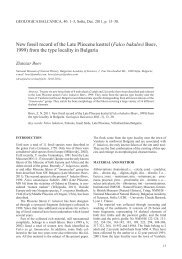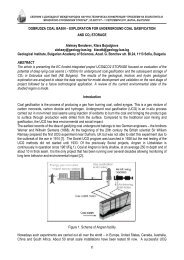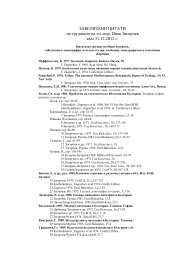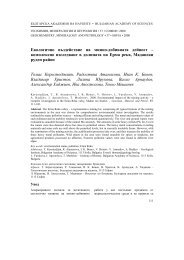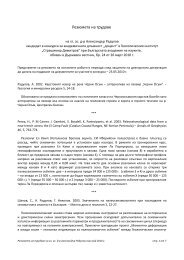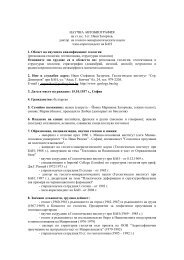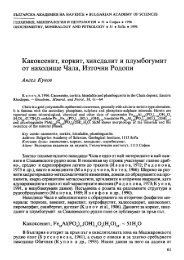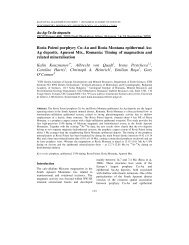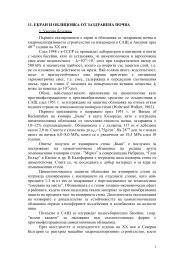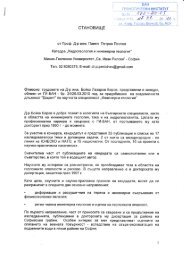Background contents of some minor and trace elements in the rocks ...
Background contents of some minor and trace elements in the rocks ...
Background contents of some minor and trace elements in the rocks ...
You also want an ePaper? Increase the reach of your titles
YUMPU automatically turns print PDFs into web optimized ePapers that Google loves.
Upper background thresholds. The values calculatedfor <strong>the</strong> upper background threshold(UBT 0.05) <strong>of</strong> <strong>the</strong> element <strong>contents</strong> (Tables 1 <strong>and</strong> 2)give a general idea <strong>of</strong> <strong>the</strong> upper limit <strong>of</strong> normalelement concentrations <strong>in</strong> <strong>the</strong> <strong>rocks</strong> most widelyspread <strong>in</strong> Bulgaria. Each rock group has its specificUBT for <strong>the</strong> <strong>in</strong>dividual <strong>elements</strong>, which may belower or higher than <strong>the</strong> respective total UBT forall <strong>the</strong> <strong>rocks</strong> (Table 1).The upper background threshold marks <strong>the</strong> limits<strong>of</strong> <strong>the</strong> normal concentrations. This value is first <strong>of</strong>all applicable for <strong>the</strong> rock groups, while for <strong>the</strong> totalpopulation <strong>of</strong> all <strong>rocks</strong> UBT has an approximatecharacter because <strong>of</strong> <strong>the</strong> element differentiationbetween <strong>rocks</strong> with different chemical <strong>and</strong> m<strong>in</strong>eralcomposition <strong>and</strong> different genesis. The total upperbackground threshold for all types <strong>of</strong> <strong>rocks</strong> comb<strong>in</strong>ed,applied to <strong>some</strong> rock types, would exclude apart <strong>of</strong> <strong>the</strong> background samples as anomalous, <strong>and</strong>for o<strong>the</strong>r types it would <strong>in</strong>clude anomalous samples<strong>in</strong>to <strong>the</strong> category <strong>of</strong> <strong>the</strong> background ones. Forexample, <strong>the</strong> total UBT for Ni is 106 ppm, but <strong>the</strong>UBT <strong>in</strong> <strong>the</strong> ultrabasic <strong>and</strong> basic <strong>rocks</strong> where <strong>the</strong>same element is concentrated are respectively 3610ppm <strong>and</strong> 192 ppm (Table 1).The width <strong>of</strong> <strong>the</strong> <strong>in</strong>terval between upper backgroundthreshold <strong>and</strong> mean content (C BG) is differentfor <strong>the</strong> <strong>in</strong>dividual <strong>elements</strong>. It depends on<strong>the</strong> variance <strong>of</strong> <strong>the</strong> background <strong>contents</strong>. Accord<strong>in</strong>gto <strong>the</strong> values <strong>of</strong> <strong>the</strong> ratio UBT 0.05/ C BG(Table 2)<strong>the</strong> <strong>elements</strong> considered form <strong>the</strong> follow<strong>in</strong>g order:Be 2.9 – Pb 3.0 – Ba 3.3 – Zn 3.4 – As 3.4 – Mn3.5 – Sr 3.6 – Sc 3.7 – Ti 4.5 – Co 4.9 – Mo 4.9 –Sn 4.9 – W 5.0 – V 5.2 – Cu 5.3 – Ni 6.2 – Cr 8.2– Hg 18.7.Exclud<strong>in</strong>g <strong>the</strong> endmost member <strong>of</strong> <strong>the</strong> row (Hg)<strong>the</strong> ratio UBT 0.05/ C BGvaries from 3 to 8, at an averageabout 4.On lower hierarchical levels (for example, forl<strong>and</strong>scapes, geological-structural or adm<strong>in</strong>istrativeregions, different rock complexes, etc.) <strong>the</strong> parameters<strong>of</strong> <strong>the</strong> background concentrations (mean content<strong>and</strong> upper background threshold) <strong>of</strong> <strong>the</strong> <strong>elements</strong>may have <strong>the</strong>ir specific local values, <strong>in</strong>cludedstatistically <strong>in</strong> <strong>the</strong> general estimates obta<strong>in</strong>ed for<strong>the</strong> whole Bulgarian territory.ConclusionThe reference values derived for <strong>the</strong> mean background<strong>contents</strong> <strong>of</strong> Be, Sr, Ba, Sc, Ti, V, Cr, Mo, W,Mn, Co, Ni, Cu, Zn, Hg, Sn, Pb <strong>and</strong> As may be acceptedas sufficiently reliable geochemical st<strong>and</strong>ards,characteris<strong>in</strong>g <strong>the</strong> chemical composition <strong>of</strong> <strong>the</strong> <strong>rocks</strong>on Bulgarian territory.The background values established are based onreal results from quantitative chemical analysespublished <strong>in</strong> Bulgarian geochemical studies dur<strong>in</strong>ga period <strong>of</strong> 40 years. In spite <strong>of</strong> <strong>the</strong> local representativity<strong>of</strong> <strong>the</strong> rock samples (for <strong>the</strong> country) <strong>the</strong> valuesderived show good co<strong>in</strong>cidence with <strong>the</strong> recentlycalculated averages <strong>of</strong> <strong>the</strong> studied <strong>elements</strong> <strong>in</strong> <strong>the</strong>upper cont<strong>in</strong>ental crust.The content <strong>of</strong> Cd <strong>in</strong> <strong>the</strong> <strong>rocks</strong> <strong>in</strong> Bulgaria needsadditional <strong>in</strong>vestigations <strong>and</strong> first <strong>of</strong> all – new dataobta<strong>in</strong>ed through highly sensitive modern analyticalmethods.The results obta<strong>in</strong>ed show that <strong>the</strong>re is no “ones<strong>in</strong>gle” background value for given element, whichcan be equally valid for all types <strong>of</strong> <strong>rocks</strong>. The <strong>in</strong>dividualrock groups are dist<strong>in</strong>guished with specificparameters <strong>of</strong> distribution <strong>of</strong> <strong>the</strong> background concentrations(mean value, variance, upper backgroundthreshold, etc.) which <strong>of</strong>ten are significantly differentfrom each o<strong>the</strong>r, especially for <strong>the</strong> <strong>contents</strong> <strong>of</strong><strong>the</strong> most <strong>in</strong>tensively differentiated <strong>elements</strong> – Hg,Cr, Ti, Ni, V, Cu <strong>and</strong> Co.The reference background values obta<strong>in</strong>ed for 18<strong>elements</strong> known as <strong>m<strong>in</strong>or</strong> <strong>and</strong> <strong>trace</strong> components <strong>in</strong><strong>the</strong> chemical composition <strong>of</strong> <strong>the</strong> <strong>rocks</strong> – Be, Sr, Ba,Sc, Ti, V, Cr, Mo, W, Mn, Co, Ni, Cu, Zn, Hg, Sn, Pb<strong>and</strong> As – may have a multipurpose application forcomparative geochemical, petrological, lithological<strong>and</strong> metallogenic <strong>in</strong>vestigations, for assessment <strong>of</strong> <strong>the</strong>quality <strong>of</strong> <strong>the</strong> environment (soils, etc.) <strong>and</strong> as regionalClarkes <strong>of</strong> <strong>the</strong>se <strong>elements</strong> for <strong>the</strong> Bulgarian territory<strong>and</strong> <strong>the</strong> Balkan region, as well.ReferencesChristova, J., Christov, D. 2006. <strong>Background</strong> <strong>contents</strong> <strong>of</strong> Be, Sr,Ba, Sc, Ti, V, Mo, W, Sn <strong>in</strong> <strong>the</strong> <strong>rocks</strong> <strong>in</strong> Bulgaria. – C. R.Acad. Bulg. Sci., 59, 2; 175—180.Darnley, A. G. 1995. Global geochemical database for environment<strong>and</strong> resource management: F<strong>in</strong>al report <strong>of</strong> IGSP projectNo 259. UNESCO; 122 p.Gao, S., Luo, T.-C., Zhang, B.-R., Zhang, H.-F., Han, Y.-W.,Hu, Y.-K., Zhao, Z.-D. 1998. Chemical composition <strong>of</strong> <strong>the</strong>cont<strong>in</strong>ental crust as revealed by studies <strong>in</strong> East Ch<strong>in</strong>a. –Geochim.&Cosmochim. Acta, 62, 11; 1959—1975.Kuik<strong>in</strong>, S., Christova, J., Christov, D. 2001. Mean concentrations<strong>of</strong> Cr, Mn, Co, Ni, Cu, Zn, As, Cd, Hg <strong>and</strong> Pb <strong>in</strong> <strong>the</strong><strong>rocks</strong> <strong>of</strong> Bulgaria. – C. R. Acad. Bulg. Sci., 54, 9; 63—68.Rudnick, R. L., Gao, S. 2003. Composition <strong>of</strong> <strong>the</strong> cont<strong>in</strong>entalcrust. – In: The Crust, Treatise on Geochemistry, v. 3,Elsevier – Pergamon, Oxford; 1—64.Tong, Li. 1995. Element abundances <strong>of</strong> Ch<strong>in</strong>a’s cont<strong>in</strong>entalcrust <strong>and</strong> its sedimentary layer <strong>and</strong> upper cont<strong>in</strong>ental crust.– Ch<strong>in</strong>ese J. <strong>of</strong> Geochemistry, 14, 1; 26—32.Turekian, K. K., Wedepohl, K. H. 1961. Distribution <strong>of</strong> <strong>the</strong><strong>elements</strong> <strong>in</strong> <strong>some</strong> major units <strong>of</strong> <strong>the</strong> Earth’s crust. – Bull.Geol. Soc. America, 72, 2; 175—192.Van de Meent, D., Aldenberg, T., Canton, J. H., von Gestel, C.A. M., Sto<strong>of</strong>f, W. 1990. Desire for levels. <strong>Background</strong> studyfor <strong>the</strong> policy document “Sett<strong>in</strong>g environmental qualityst<strong>and</strong>ard for water <strong>and</strong> soil”. – Engl. vers. from dutch,RIVM – report No 670101.001 – “Streven Naar Waarden”;52 p.Wedepohl, K. H. 1995. The composition <strong>of</strong> <strong>the</strong> cont<strong>in</strong>entalcrust. – Geochim.&Cosmochim. Acta, 59, 7; 1217—1232.Âåðíàäñêèé, Â. È. 1954. Èçáðàííûå ñî÷èíåíèÿ, ò. 1. Ìîñêâà,ÀÍ ÑÑÑÐ; 396—410; 519—527.74



